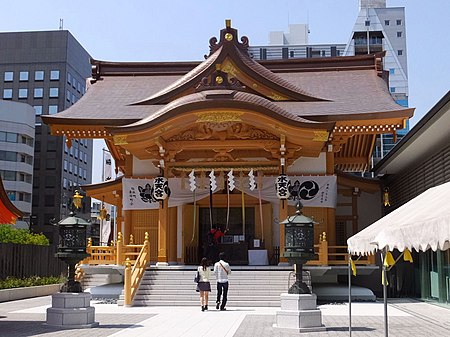Suitengū (Tokyo)

Suiten-gū (水天宮), literally "Palace of the Water Deva", or "Palace of Suiten", is a Shinto shrine dedicated to four deities: Amenominakanushi Antoku Kenrenmon-in Nii No Ama"Suiten" is the Japanese name of the deity of Hindu origins Varuna, one of a series of Hindu deities whose worship entered Japan together with Buddhism.. When the Japanese Empire enforced the Shinbutsu bunri, the official separation of Shinto shrines and Buddhist temples, shrines celebrating Suiten identified their dedication to Amenominakanushi.Suitengu is located in Chūō, Tokyo. It is devoted to conception and safe childbirth. In 1818 the ninth daimyō of the Kurume Domain established the Suitengu in Edo as a branch of a shrine of the same name in Kurume, Fukuoka. It was inside the grounds of the domain's mansion in the Mita district of what is now Minato, Tokyo, and the domain opened it to the public on the fifth day of every month. In 1871, the Arima family moved from Mita to Akasaka, taking the shrine with them, and in the following year they moved the shrine to its present location, on a site that had been occupied by one of the family's mansions. Suitengūmae Station is close to this shrine and takes its name from it. There are about twenty-five other shrines of the same name in Japan.
Excerpt from the Wikipedia article Suitengū (Tokyo) (License: CC BY-SA 3.0, Authors, Images).Suitengū (Tokyo)
Suitengu-dori, Chuo
Geographical coordinates (GPS) Address Phone number Website External links Nearby Places Show on map
Geographical coordinates (GPS)
| Latitude | Longitude |
|---|---|
| N 35.683611111111 ° | E 139.785 ° |
Address
水天宮
Suitengu-dori
103-0014 Chuo
Japan
Open on Google Maps








